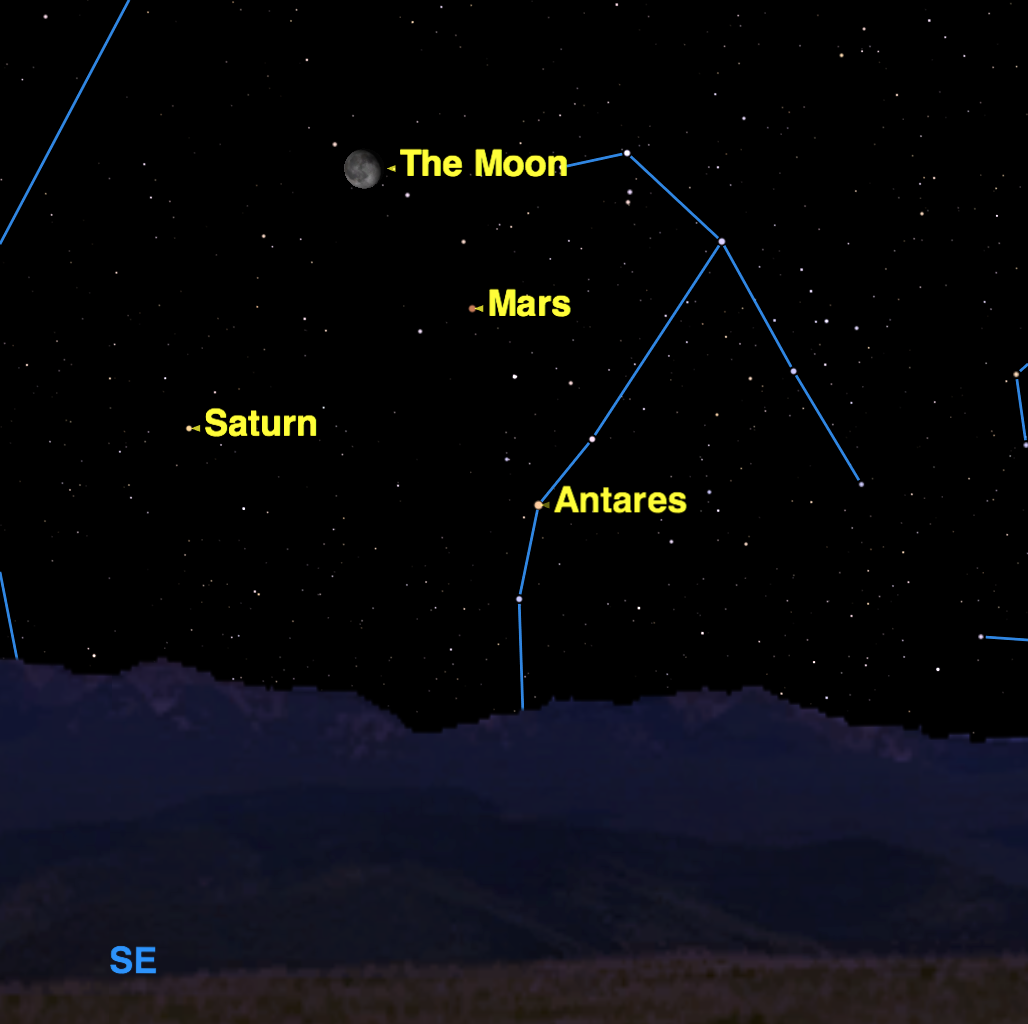
On the night of Sunday, April 24, stay up just past midnight to see a spectacular sight in the southeastern sky: the waning gibbous moon, the two planets Mars and Saturn, and the bright red star Antares.
Credit: Starry Night Software
If you stay up a little past midnight tonight (April 24), you will see in the southeastern sky an amazing gathering of bright celestial objects.
Weather permitting, at around 1 a.m. (your local time) this weekend you will have a chance of spotting a grouping of the red giant star Antares and the two bright planets Mars and Saturn. What makes Sunday night (or rather Monday morning) special is that these three will be joined by a waning gibbous moon, just three days past full.
The sight of these four bright objects is a treat for any sky gazer, and can be appreciated without the need of any optical aid.
Observers with small telescopes will find each of these objects worthy of further study.
The waning gibbous moon is always interesting to look at because we see the surface features familiar from the crescent moon, but with the light falling in the opposite direction. The sun is setting over the Mare Nectaris, throwing into sharp relief the three prominent craters on its western edge: Theophilus, Cyrillis and Catharina, and the Altai Scarp to its south.
Mars is currently moving toward opposition on May 22, followed by its closest approach to Earth in many years on May 30. Its disk has now grown to 15 arc seconds in diameter, large enough that moderate-size amateur telescopes should reveal its patterns of dusky markings. It is currently close to the equinox on Mars, so don’t expect to see much of its polar caps.
Saturn is, of course, the greatest treasure in the sky for the small telescope. The second largest of the planets, its spectacular ring system is now spread close to its widest. See how many of its tiny moons you can spot. Giant Titan is visible in any telescope, and half a dozen more moons can be spotted with larger amateur telescopes. Use a program like Starry Night or SkySafari to identify the individual moons. Unlike Jupiter’s moons, which always arrayed more or less in a straight line, Saturn’s moons can appear at any angle from the planet.
Don’t neglect the star Antares. Its name suggests a similarity to Mars, whose Greek name is Ares. Like Mars, it appears orange or red to the naked eye. If you have a good telescope and steady skies, look close in toward the brilliant red of Antares for a speck of green, for Antares is a double star: a very bright red giant accompanied by a tiny blue-white companion. Because of Antares’ strong red color, the companion often appears green in color, but this is an optical illusion.
To give you some idea of how big this red giant star is, if it were placed at the center of our solar system, its outer surface would lie between the orbits of Mars and Jupiter. Its “tiny” companion is actually much larger and 170 times brighter than our own sun.
Editor’s note: If you snap an awesome photo of Mars, Saturn, Antares and the moon together and would like to share it with Space.com and our news partners for a story or gallery, send images and comments in to managing editor Tariq Malik at spacephotos@space.com.
This article was provided to Space.com bySimulation Curriculum , the leader in space science curriculum solutions and the makers of Starry Night and SkySafari . Follow Starry Night on Twitter @StarryNightEdu . Follow us @Spacedotcom , Facebook and Google+ . Original article on Space.com .
Comments are closed.